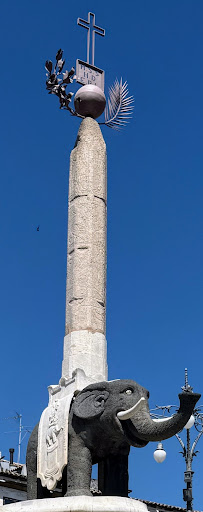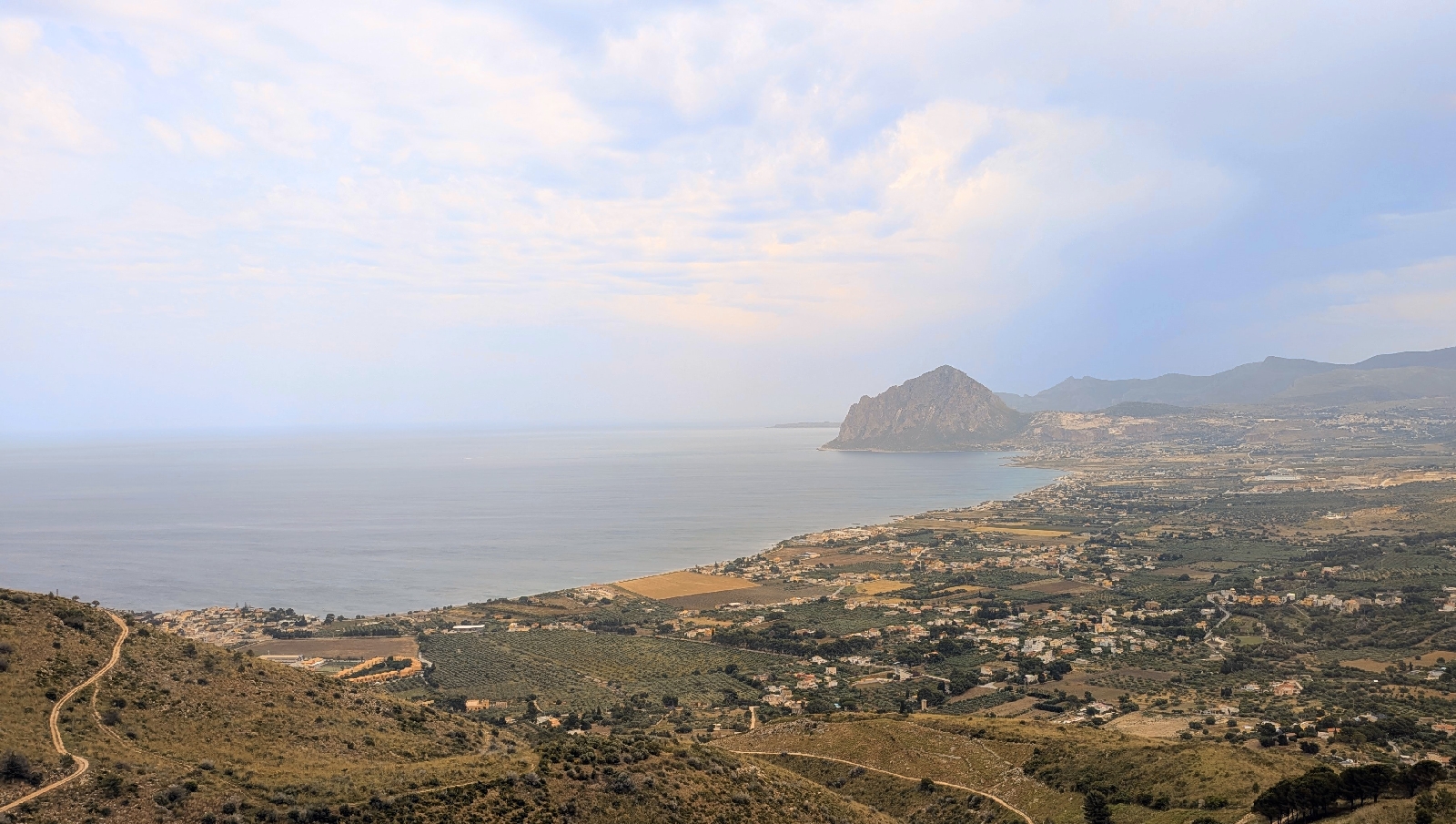Catania - last stop in Sicily
Catania was one of the first Greek settlements on Sicily, and came into its own, when it was likely the largest Roman city in Sicily. It had two large theaters and a smaller building for musical performances, as well a stadium almost as big as Circus Maximus in Rome.
But time, natural disasters, invasion, and urbanization erased much of the ancient city, and now only scattered remnants can be found. In 1669 Mt. Etna opened a new flank crater and lava surrounded city (Christine talked about these in her post about Mt Etna). Most Greek and Roman structures were buried, but within the city walls, the city was spared, but with a very changed coastline. Then in 1693, there was the terrible earthquake, we’ve mentioned before, which destroyed 1/3 of all of Sicily including Catania. In the early 1700s, Catania started being rebuilt in the baroque style, which was popular at that time. In 1943, the city was destroyed again by the allied bombings. I think that sounds like a lot for a city to go through.
Our bus dropped us off outside the city center and we entered through the port gate.
The first thing we noticed was that rather than the white or yellow of many buildings in the Mediterranean, a lot of the buildings were made of blackish stone. I had never seen this before and it was because they were made from volcanic rock. You can see that both in the port gate above and the building below.
The patron saint of Catania is St Agatha. She was killed by Roman’s by torture and part of that was cutting off her breasts. She is the patron saint for breast cancer, victims of sexual abuse, nurses and those affected by natural disasters - especially volcanic eruptions and fires. Catania is proud they have the 3rd biggest religious festival in the world, every year in early February for St Agatha.
Even the viceroy uses this ceremonial carriage to start the procession of Saint Agatha.
This was the first piazza we came to and in the middle of it was this monument with a small elephant at the bottom. The elephant statue is of unknown origin. It was here before the Greeks came and the elephant is made in lava stone. It is the pagan symbol of Catania. There is archeological evidence that elephants did live in Sicily and they had evidence that they were approximately the size of bears. They are extinct now.
Next, like the good tour group we are, we took a walk with our group through the historical part of the city.
There are many under ground rivers through lava tubes in the city. This statue and water is where one reaches the surface.
Daily fish market where locals and restaurants get their fresh fish.
Colorful market and umbrellas decorating a seating area.
Our guide took us into a local restaurant where not too many years ago a discovery was made below it………..
You guessed it! An ancient lava tube, with the river running thru it, I didn’t get a picture of the steps, but there were ancient steps carved out of the lava leading to it.
And a few feet from the steps…..lots of crazy looking decorations like this. What a combo - prehistory and paper mache!
We came across a Roman bath made of lava stone, that was not destroyed in earthquake.
Then a castle just hanging out in the middle of the city. It was built by Frederico Secondo (same guy who was an ancestor to the contessa we met the first day)- Castello Ursino- was never ruined. It is a perfect 13th century medieval castle built in lava stone, just sitting in the city without any kind of decay and very little wear. It use to be surrounded by water moat. Even though it was outside the city walls, lava didn’t take it because it was stopped in the moat. The big earthquake did not touch it and the allied bombings missed it. Many locals say that when it was built, all the different religions symbols of protection were built into the castle somewhere. For example, 5 point star (pentagram), a menorah, saints etc to protect castle. Hmmmmm
We headed back to the city center since it was time to head to the museum. But first ….. food….again! Andrea called this a snack…large pastry filled with ham, cheese and onion….a snack to tide us over to lunch! Christine decided to eat it in the earthquake free zone right below the ancient elephant statue.
We piled ourselves back on the bus and headed to a sobering WWII museum. The historical museum was about the landing of Sicily by the allied forces. Entering the museum, this saying took up a whole wall.
It says “ Nothing is lost with peace, everything is lost with war”
The museum started with a recreation of a typical Sicilian piazza, then we went into a “bomb shelter”, with the experience of the shaking and dark of an air raid. Then we exited to the same town square after the bomb.
The museum was mostly presented only in Italian and told the parts that each army was responsible for. I didn’t take any pictures of that, but I did of the poster below. I hope the lines are readable for those looking at it here. The chart shows the statistics for the deaths for each country. The first column is civilians, the second column is military, the third column is the Jews. I actually stood there in shock for more than a few minutes.
As we exited the building you could still see a bunker along the Mediterranean Sea.
There is no way to have a good segue, so I won’t attempt it.
We headed to the hotel and the indulged in a granita with brioche - before dinner. These skinny Sicilians eat like crazy”
After having a final happy hour and dinner, we said goodbye to our new friends.
We are not done yet though!
Christine and I had one more day to explore Catania on our own and we headed out with a plan to see churches, ruins and do some shopping. First thing, we ran into a HUGE market. It took up several city blocks and had everything you could possibly think of to buy.
Here’s Christine, pretty excited that she got some good deals.
Next on to the Piazza Duomo, and the Cathedral of St Agatha. It was originally built in medieval times, but most collapsed during the earthquake.
I show the above resting place because it is for Vincenzo Bellini. The Sicilians are mighty proud of this composer. We heard about him several times. I wanted to include the picture to remember how proud Sicilians are of any of their famous and slightly famous people.
Below are the mummified hands of Giuseppe Benedetto Dusmet. He was a monk and a cardinal. The remains are just in the middle of the cathedral and look mighty creepy.
The cathedrals apses, on either side of the main altar area are the medieval parts that survived the earthquake.
Next, on to the Abbey of St Agatha, baroque style church with an attached female convent. It had beautiful frescos and paintings, but we had heard you could take the stairs up to the dome to have a view of the city….and of course we climbed up.
Views from up top.
Coffee break-aka potty break! We have learned that where there are no public bathrooms, you go buy something small and then use the restroom. Look how cool the cappuccino mug looked where we stopped! Christine is the one hovering in the mirror.
And then on a walk to our next stop… Spider-Man was crawling up the building.
Saw a most colorful juice stand.
And found another piazza (one of many) showing how you can get away from the buildings in case of earthquake.
Next stop….. An open-air amphitheater ruins from the 2nd century AD with a stepped seating area & an orchestra pit. It was used until 5th/6th century and then it had houses built on and into it which were lived in until 1959. It is back to being used as an amphitheater again as well as a museum and tourist stop.
This view from above, I took off of their website to show how it just sits in the middle of the city.
The amphitheater sits at the bottom of a street of multiple baroque churches. Many were for religious orders, the arched passageway above the road was a walkway for the nuns to go to the church. Because we were there in the middle of the siesta hours, most of the churches were closed, but we were able to visit one. It was Chiesa di San Giuliano. (Church of San Giuliano) https://chiesadisangiulianocatania.wordpress.com/
This view is from the very tip top of the cupola on the church-OF COURSE we climbed up there!
When Catania was destroyed by the aforementioned earthquake, the cloistered Benedictine nuns of San Giuliano settled in the "new" part of Catania, on Via Crociferi, formerly known as Via dei Tre Santi and where the current Church of San Giuliano stands.
Building is unique octogonal shape. The wooden cross is from 14th century .
Theis statue of the Crucifix shown below is very unique, the type of marble used is very rare and precious, it is a veined red alabaster.
This is where the nuns would be to be able to see the mass without being seen.
Very little remains of the ancient sacristy; this is because after 1866 with the law of suppression of monastic orders. The laws led to the state taking control of monastic lands, buildings, and other assets. One such building was the convent attached to the church, shown below.
Christine is headed up to the cupola, while I try out the bells.
The day was running short, so just a few more stops. First to the ancient Roman colosseum, just in the middle of 4 lanes of traffic. We decided enough ruins for this trip, so we just looked at it from street level.
On to the public gardens.
And that was it folks! Great food, Beautiful scenery, unique experiences, interesting history and wonderful companions! We had it all! Time for me to head home and on to Amsterdam for Christine!































































Thanks for a great trip, Mary! And for this blog to help us remember it all.
ReplyDeleteSo glad you had such a fantastic visit to Sicily! Thanks for sharing all your experiences with us!
ReplyDelete